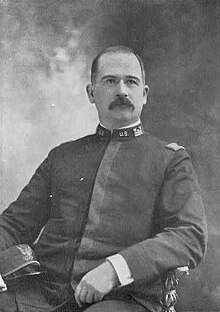| Thomas Lincoln Casey Jr. | |
|---|---|
 Casey in 1898 Casey in 1898 | |
| Born | (1857-02-19)February 19, 1857 West Point, New York, U.S. |
| Died | February 3, 1925(1925-02-03) (aged 67) Washington, D.C., U.S. |
| Buried | Arlington National Cemetery, Arlington, Virginia, U.S. |
| Allegiance | |
| Branch | |
| Years of service | 1875–1912 |
| Rank | |
| Battles / wars | Spanish–American War |
| Alma mater | United States Military Academy |
| Relations | Thomas Lincoln Casey Sr. (father) Edward Pearce Casey (brother) |
| Other work | Entomology Astronomy |
Thomas Lincoln Casey Jr. (February 19, 1857 – February 3, 1925) was an American army engineer and entomologist who was noted for his work on Coleoptera. He was the eldest son of Brigadier General Thomas Lincoln Casey (1831–1896), who served as Chief of Engineers for the United States Army Corps of Engineers and oversaw the completion of the Washington Monument.
Military career
Casey was born in West Point, New York. He followed in his father's footsteps and attended the United States Military Academy at West Point. He entered the academy in 1875 and graduated second in his class in 1879, when he was commissioned a 2nd lieutenant in the Corps of Engineers.
He was promoted to 1st lieutenant in June 1881 and to captain in July 1888. From 1895 he was assigned to construction of fortifications at Fort Monroe and the Hampton Roads area in Virginia. In July 1898, he was promoted to major and supervised the installation of underwater mines to defend Hampton Roads during the Spanish–American War. He then served at Vicksburg, Mississippi from 1899 to 1901 and was in charge of Mississippi river improvements at St. Louis, Missouri from 1901 to 1906.
In 1906, he was promoted to lieutenant colonel. In 1909, he was promoted to colonel and assigned as engineer secretary to the Lighthouse Board until 1910. Casey retired from the army on November 1, 1912.
Scientific work
He published numerous scientific papers on the subject of Coleoptera and a monograph, Memoirs on the Coleoptera (1910–1924). He was also known for contributions to astronomy.
Later life
Casey died on February 3, 1925 in Washington, D.C. He was interred at Arlington National Cemetery three days later.
Bibliography
Coleopterological works:
- Casey T. L. 1910–1924. Memoirs on the Coleoptera.
Malacological work:
- Casey T. L. 1904. Notes on the Pleurotomidae with description of some new genera and species. Transactions of the Academy of Science of St. Louis, volume 14, number 5, pages 123–170.
References
- United States Army Corps of Engineers-Thomas Lincoln Casey, Jr.
- George Washington Cullum (1920). Biographical register of the officers and Graduates U.S. Military Academy.
- Brett Ratcliffe (2007) Univ. Nebraska, Lincoln, Scarab workers--accessed 20 March 2007
- R.G. Aitken (1925). Publications of the Astronomical Society of the Pacific, Vol. 37, No. 219, p.265 (PDF)
- ^ "Died: Casey". The Washington Post. February 4, 1925. p. 5. Retrieved 29 July 2024.
- "Thomas Lincoln Casey". Fifty-sixth Annual Report of the Association of Graduates of the United States Military Academy at West Point, New York. Saginaw, Michigan: Seemann & Peters Printers and Binders. June 11, 1925. pp. 183–185. Retrieved 29 July 2024.
- "Casey, Thomas L". ANCExplorer. U.S. Army. Retrieved 29 July 2024.
External links
- Thos. L. (Thomas Lincoln) Casey Papers
- Works by or about Thomas Lincoln Casey Jr. at the Internet Archive
- 1857 births
- 1925 deaths
- People from West Point, New York
- United States Military Academy alumni
- United States Army Corps of Engineers personnel
- Military personnel from New York (state)
- American entomologists
- American astronomers
- Scientists from New York (state)
- American military personnel of the Spanish–American War
- United States Army colonels
- Burials at Arlington National Cemetery